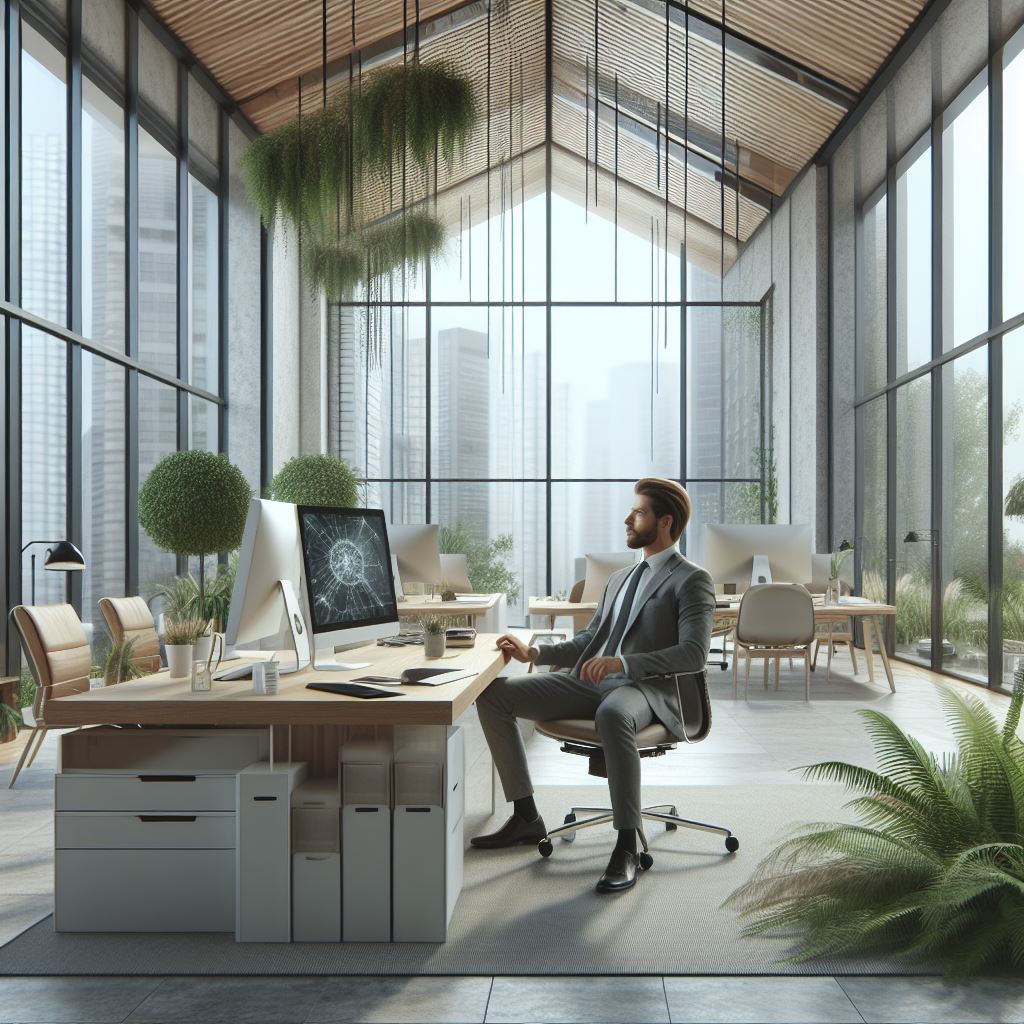Introduction
The COVID-19 pandemic has left an indelible mark on the landscape of traditional office spaces, reshaping the way we work and interact within professional environments.
As the virus swept across the globe, organizations were forced to implement unprecedented measures to ensure the safety and well-being of their employees.
The once bustling offices transformed into deserted spaces, echoing the uncertainties that permeated the professional realm.
The impact was profound, prompting a paradigm shift in how businesses approached the concept of workspace.
Traditional cubicles and open-floor plans, once synonymous with collaboration and camaraderie, became potential breeding grounds for contagion.
Remote work emerged as a viable alternative, challenging the traditional nine-to-five model and underscoring the need for adaptability in the face of unforeseen disruptions.
As we navigate the post-pandemic era, understanding the evolution of office spaces in the United States is paramount.
The concept of the ‘new norm’ extends beyond mere physical adaptations; it encompasses a redefinition of workplace culture, communication dynamics, and the very essence of professional engagement.
Exploring the new US norm for post-COVID office spaces is not merely an intellectual exercise; it is a practical necessity.
Businesses, both large and small, are reevaluating their strategies to foster a safe and productive work environment.
Remote work, once considered a temporary measure, has woven itself into the fabric of the modern workplace.
As we delve into this post, we will dissect the architectural, technological, and cultural facets that define the emerging trends in office spaces across the United States.
In the sections that follow, we will unravel the innovative solutions that architects and designers are deploying to create spaces that prioritize health, collaboration, and flexibility.
The Rise of Remote Work
Increased adoption of remote work during the pandemic
The COVID-19 pandemic reshaped the landscape of office spaces across the United States, ushering in an era where remote work became not just a trend but a norm.
As lockdowns and social distancing measures took hold, businesses quickly adapted by embracing the virtual workspace.
Transform Your Real Estate Decisions
Unlock personalized real estate insights crafted just for you. Get actionable advice designed to amplify your success.
Get StartedA surge in technology adoption facilitated this transition, allowing employees to seamlessly connect from the comfort of their homes.
Organizations that initially resisted remote work found themselves compelled to embrace it for business continuity.
Video conferencing tools became the lifeline for meetings, and collaboration platforms transformed the way teams interacted.
The remote work paradigm shift was not just a temporary solution but a catalyst for a more flexible and dynamic work environment.
Benefits and challenges of remote work for both employees and employers
Remote work brought forth a myriad of benefits, both for employees and employers.
For employees, the newfound flexibility translated into improved work-life balance.
Commute times were replaced with more productive hours, fostering a sense of autonomy.
Employers, in turn, witnessed increased employee satisfaction, leading to higher retention rates.
However, the shift to remote work was not without its challenges.
Employees grappled with feelings of isolation and the blurred boundaries between personal and professional life.
Employers faced the task of ensuring effective communication, maintaining team cohesion, and addressing cybersecurity concerns in a decentralized work environment.
Despite the challenges, the benefits of remote work prevailed.
Employers discovered that productivity need not be confined to traditional office settings.
Remote work opened the door to a broader talent pool, allowing organizations to tap into diverse skill sets without geographical constraints.
Showcase Your Real Estate Business
Publish your company profile on our blog for just $200. Gain instant exposure and connect with a dedicated audience of real estate professionals and enthusiasts.
Publish Your ProfileAs the dust settled, a hybrid approach emerged, acknowledging the value of both in-person collaboration and remote flexibility.
The post-COVID office space in the United States became a dynamic blend of physical and virtual elements, reflecting a new norm that prioritized adaptability and efficiency.
Read: 2024 US Office Space Market: Trends and Outlook
Hybrid Work Models
Definition and Concept of Hybrid Work Models
A hybrid work model combines remote work and in-person work, allowing employees to have flexibility in their workplace arrangements.
It involves a blend of working from home and working in the office.
Unlike traditional office setups where employees are expected to be in the office every day, hybrid work models provide a more flexible approach.
Employees have the freedom to choose where they work from, whether it’s at home or in the office.
The concept of hybrid work models rose in popularity during the COVID-19 pandemic when remote work became a necessity.
Companies realized that employees could effectively work from home, leading to the rise of hybrid work models as a viable long-term option.
Advantages and Disadvantages of Implementing a Hybrid Work Model in Offices
Advantages
- Flexibility: Hybrid work models offer employees the freedom to work from a location that suits them best, promoting work-life balance.
- Cost savings: Companies can save costs on office space and utilities when employees work remotely part-time.
- Talent retention: Offering hybrid work options can attract top talent and boost employee satisfaction.
- Inclusion: Hybrid work models can provide opportunities for those who may face barriers to in-person work, such as individuals with disabilities or caretaking responsibilities.
Disadvantages
- Communication challenges: Coordination and collaboration can be more challenging when some team members are remote and others are in the office.
- Reduced social interaction: Remote work can lead to less face-to-face interaction and potentially impact team cohesion.
- Work-life balance blur: Without proper boundaries, employees may struggle to separate work and personal life when working from home.
- Technological requirements: Implementing a hybrid work model requires reliable technology and infrastructure to support seamless remote collaboration.
Examples of Companies Successfully Implementing Hybrid Work Models
Several companies have successfully embraced hybrid work models:
Microsoft
Microsoft announced that employees can choose to work remotely for less than 50% of their working week.
Twitter announced permanent remote work possibilities and even offered employees the option to work from home forever.
Dropbox
Dropbox introduced a “Virtual First” approach, allowing employees to work remotely and reimagining office spaces as collaborative hubs.
Shopify
Shopify announced a permanent remote work option, giving its employees the freedom to work from anywhere.
These examples demonstrate that hybrid work models can be successfully implemented across different industries and provide employees with flexibility and choice.
Overall, hybrid work models offer numerous advantages such as increased flexibility and cost savings, while also presenting challenges like communication and work-life balance.
By learning from successful implementations, companies can tailor hybrid work models to suit their specific needs and create a new US norm.
Read: Mixed-Use Properties: Pros & Cons

Flexibility and Adaptability in Office Spaces
The seismic shift in the working landscape ushered in by the COVID-19 pandemic has led to a reevaluation of traditional office spaces in the United States.
The new norm is defined by flexibility and adaptability, transforming the once rigid structures into dynamic environments that cater to the evolving needs of the workforce.
Redefining office layouts and floor plans to accommodate more flexible working arrangements
Gone are the days of fixed cubicles and static workstations.
Post-COVID office spaces prioritize flexibility, with layouts designed to facilitate diverse working arrangements.
Hot-desking gains prominence as employees move away from the conventional 9-to-5 routine.
Adaptable furniture and modular spaces allow seamless transitions between collaborative brainstorming sessions and solitary focused work, fostering an agile work environment that mirrors the fluidity of modern work patterns.
Integration of technology for remote collaboration and communication purposes
As the lines between in-person and remote work continue to blur, technology takes center stage in the new office paradigm.
Advanced video conferencing systems and virtual collaboration tools become integral components, connecting teams across geographies seamlessly.
Office spaces are equipped with state-of-the-art communication infrastructure to ensure that the virtual and physical realms complement each other, providing a cohesive experience for employees, irrespective of their location.
Creating adaptable spaces that can easily be reconfigured for various purposes
The future-forward office places a premium on adaptability.
Spaces are designed with versatility in mind, allowing quick and easy reconfiguration to accommodate diverse needs.
Whether it’s transforming a meeting room into a project workspace or converting a communal area into a venue for employee wellness activities, the ability to adapt to evolving requirements is embedded in the DNA of these contemporary offices.
Showcase Your Real Estate Business
Publish your company profile on our blog for just $200. Gain instant exposure and connect with a dedicated audience of real estate professionals and enthusiasts.
Publish Your ProfileIn essence, the post-COVID office space in the United States is characterized by its commitment to flexibility and adaptability.
By redefining layouts, integrating cutting-edge technology, and emphasizing versatile spaces, these work environments are primed to meet the demands of a workforce that thrives on agility and innovation.
As we navigate the evolving landscape, these dynamic office spaces serve as a testament to the resilience and adaptability of the American workplace.
Read: Office Design Trends in 2024
Health and Safety Measures
Importance of prioritizing health and safety in office spaces
In the wake of COVID-19, it has become imperative for offices to prioritize the health and safety of their employees.
Maintaining a safe working environment is crucial not only for the well-being of the workforce but also for the overall productivity of the organization.
Employees who feel safe and protected are more likely to perform better and remain committed to their work.
Implementation of enhanced cleaning and sanitization protocols
To ensure the health and safety of employees, offices must implement enhanced cleaning and sanitization protocols.
Regular and thorough cleaning of high-touch areas, such as doorknobs, elevator buttons, and shared equipment, is essential.
Using appropriate cleaning agents and disinfectants can help eliminate viruses and bacteria that may be present in the office environment.
Incorporation of social distancing measures and updated ventilation systems
Social distancing measures play a crucial role in preventing the spread of infectious diseases within office spaces.
Offices should redesign their layouts to maintain a safe distance between employees, either by rearranging workstations or implementing physical barriers.
In addition to social distancing, updating ventilation systems with high-efficiency air filters can greatly improve air quality and minimize the risk of airborne transmission.
Adoption of touchless technologies and contactless interactions
To reduce the need for physical contact and minimize the risk of transmission, offices should adopt touchless technologies and contactless interactions.
Motion sensor-operated doors, automatic hand sanitizers, and voice-activated controls are some examples of touchless technologies that can be implemented.
Using digital platforms for communication and minimizing the sharing of physical documents can also contribute to a safer work environment.
All in all, prioritizing health and safety in office spaces is of utmost importance in the post-COVID era.
Implementing enhanced cleaning protocols, incorporating social distancing measures, updating ventilation systems, and adopting touchless technologies are key strategies to ensure the well-being of employees.
By prioritizing health and safety, organizations can create a conducive work environment that fosters productivity and maintains the trust of their employees.
Read: Future of Retail: Malls vs Online
Employee Well-being
In the wake of the pandemic, the paradigm of office spaces in the United States has undergone a revolutionary shift, with an overarching emphasis on IVI – Integrated Employee Well-being.
Corporations are recognizing the pivotal role that a positive and stimulating work environment plays in fostering productivity and employee satisfaction.
Focus on creating a positive and stimulating work environment
Gone are the days of drab cubicles and monotonous layouts. Post-COVID office spaces are embracing vibrant designs and open layouts to cultivate a positive ambiance.
Collaborative spaces encourage interaction among team members, fostering a sense of community and shared purpose.
The infusion of natural light and greenery further contributes to an uplifting atmosphere, boosting both mood and productivity.
Integration of wellness areas, such as designated spaces for physical activity or relaxation
Recognizing the importance of physical and mental well-being, companies are integrating wellness areas into their office blueprints.
Designated spaces for physical activity, whether it’s a gym, yoga studio, or walking trails, promote a healthy lifestyle.
These spaces not only contribute to employee fitness but also serve as rejuvenating breaks, enhancing overall well-being.
To complement physical wellness, relaxation zones are strategically placed throughout the office.
Comfortable seating, calming colors, and even nap pods offer employees a chance to recharge during hectic workdays.
Showcase Your Real Estate Business
Publish your company profile on our blog for just $200. Gain instant exposure and connect with a dedicated audience of real estate professionals and enthusiasts.
Publish Your ProfileThese well-thought-out spaces underline the commitment to employee-centric office design.
Enhancement of mental health support services for employees
Understanding the toll that the pandemic has taken on mental health, corporations are placing a renewed emphasis on mental health support services.
Employee assistance programs, counseling services, and workshops on stress management are becoming integral parts of the corporate landscape.
The aim is to create a work environment where employees feel supported and can openly discuss their mental health concerns without fear of stigma.
Therefore, post-COVID office spaces in the United States are embracing the IVI approach with a strong focus on employee well-being.
By creating positive environments, integrating wellness areas, and enhancing mental health support services, companies are not only adapting to the new normal but actively prioritizing the health and happiness of their most valuable asset – their employees.
Future of Office Spaces in the US
The aftermath of the COVID-19 pandemic has reshaped the landscape of office spaces in the United States.
As we step into the post-COVID era, the future of office spaces is characterized by unprecedented shifts and adaptability.
Predictions and trends for the future of office spaces
The traditional 9-to-5 office routine is evolving into a hybrid model, combining remote work and in-office collaboration.
Flexibility emerges as a key theme, with companies embracing a dynamic approach to work environments.
Remote work, once a necessity, is now a viable long-term solution, allowing employees to balance professional and personal life effectively.
Collaborative spaces and flexible work hours are predicted to become the norm.
Offices are transforming into hubs for innovation and teamwork, fostering creativity and social interactions.
The focus is shifting from mere productivity to holistic employee well-being, recognizing the importance of mental health and work-life balance.
Anticipated long-term impacts on the real estate industry
The real estate industry is undergoing a paradigm shift, adapting to the changing needs of businesses.
As remote work gains popularity, there’s a reduced demand for large office spaces.
Companies are reevaluating their real estate portfolios, leading to a surge in demand for smaller, more flexible spaces that cater to collaborative efforts.
Suburban office spaces are gaining traction as employees seek proximity to home while avoiding crowded urban centers.
The shift towards flexible leasing agreements and shared workspaces is on the rise, allowing businesses to scale their office footprint based on current requirements.
The necessity for continual adaptation and flexibility in response to changing circumstances
The key takeaway from the post-COVID office space evolution is the imperative need for ongoing adaptation and flexibility.
Businesses must remain agile, ready to adjust policies and spaces in response to evolving circumstances.
Technology plays a pivotal role, facilitating seamless communication and collaboration between remote and in-office teams.
Embracing change is no longer an option but a necessity.
Companies that prioritize adaptability will thrive in the dynamic landscape of post-pandemic office spaces.
The future belongs to those who can balance the benefits of remote work with the collaborative advantages of physical office spaces, creating an environment that fosters innovation, connectivity, and employee well-being.
Conclusion
Throughout this post, we have explored the emerging trends in post-COVID office spaces in the United States.
We discussed the shift towards flexible work arrangements, the increased importance of health and safety measures, and the integration of technology to facilitate remote collaboration.
As we navigate the aftermath of the COVID-19 pandemic, it is crucial for businesses and employees to embrace and adapt to the new normal in office spaces.
By implementing the necessary changes, such as redesigning layouts, implementing touchless technology, and providing flexible work options, we can create safer and more productive work environments.
It is time to prioritize the health and well-being of our workforce, while also embracing technology and flexibility to increase efficiency and adaptability.
Showcase Your Real Estate Business
Publish your company profile on our blog for just $200. Gain instant exposure and connect with a dedicated audience of real estate professionals and enthusiasts.
Publish Your ProfileBy doing so, we can build resilient workspaces that can withstand future challenges.
As we move forward, it is important for organizations and individuals to proactively prepare for the changes ahead.
This includes investing in the necessary infrastructure, training employees on new protocols, and fostering a culture of adaptability and resilience.




